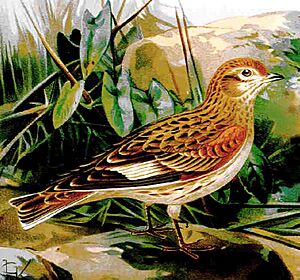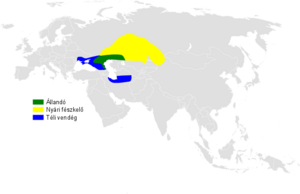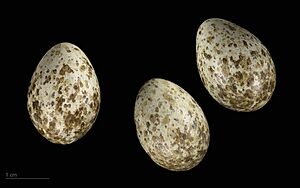White-winged lark facts for kids
Quick facts for kids White-winged lark |
|
|---|---|
 |
|
| Conservation status | |
| Scientific classification | |
| Genus: |
Alauda
|
| Species: |
leucoptera
|
 |
|
| Synonyms | |
|
|
The white-winged lark (Alauda leucoptera) is a special type of lark bird. You can find it in places like southern Ukraine, Kazakhstan, and south-central Russia. These birds often travel south when winter comes, but some stay in warmer areas all year. It's very rare to see one in western Europe.
Contents
What's in a Name?
The name Alauda comes from a Latin word for "lark." The second part of its name, leucoptera, means "white-winged." This comes from two Greek words: leukos (meaning "white") and pteron (meaning "wing").
Before 2014, scientists thought the white-winged lark belonged to a different group called Melanocorypha. But now, it's officially part of the Alauda group.
What Does It Look Like?
This lark is a large and strong bird. It has bright white patches on its wings that are easy to spot when it flies. It usually grows to be about 17 to 19 centimeters (7 to 7.5 inches) long. Its wings can spread out to about 35 centimeters (14 inches) wide.
Both male and female white-winged larks weigh around 44 grams (1.5 ounces). When they fly, you can clearly see their unique wing pattern. The outer feathers are black, the inner feathers are white, and the rest of the wing is a reddish-brown color.
The bird's body is mostly gray with dark streaks on its back. Its belly is a whitish color. Adult male larks have a reddish-brown cap on their heads. Otherwise, male and female larks look quite similar.
Its Song
The white-winged lark has a beautiful song. It sounds like a more musical version of the song sung by the Eurasian skylark.
Where It Lives and What It Does
White-winged larks like to live in dry, open areas called steppes and plains. They build their nests on the ground. A female lark will usually lay between three and eight eggs at a time.
Their diet changes with the seasons. They mostly eat seeds. But during the time when they are raising their young, they also eat insects. In the winter, these larks like to gather in groups.
Protecting the Larks
One of the biggest dangers to the white-winged lark is when their natural home is destroyed. This often happens when land is plowed for farming.
Is It Safe?
Even though the number of white-winged larks has gone down quite a bit, there are still many of them around. Because of this, they are not currently considered to be in danger of disappearing.



